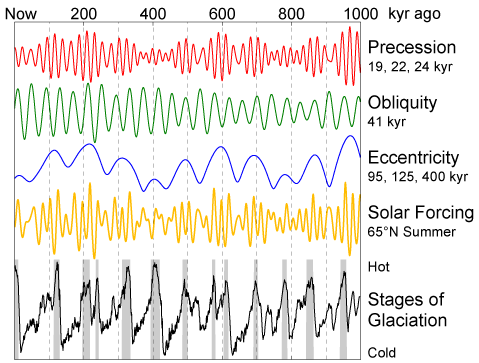If you haven't yet, read this post to find out what "green Sahara" means.
The Sahara, a place that we know to be a near-lifeless expanse of hot desert, was once a humid and highly vegetated environment? Only six thousand years ago? How could this be? I know, reader: the information in my last post shattered your reality. Please pull it back together, and make yourself a nice cup of tea. In this post I'm going to outline the natural processes that drive North Africa to flip between green and desert states, and discuss how humans have used modelling to understand these mechanisms.
At the heart of this issue is Milankovitch theory, named after the Serbian astrophysicist who developed it in the early 20th century. It holds that the Earth's orbital parameters have cycles of variation which determine not only the amount of solar radiation Earth receives, but also the spatial and temporal distribution of this energy (if you want a refresher, click here and here for an excellent, in-depth primer). Their combined rhythm is what drives many of our planet's climatic trends on a long term basis.
 |
| The pacing of the Earth's glaciation cycles by the Milankovitch cycles. |
When evidence for the green Sahara was first emerging, atmosphere general circulation models (AGCMs) were used to explore the effect of mid-Holocene orbital forcing on climate in North Africa. Since these models could be run repeatedly with minor changes, they were used to determine the sensitivity of the results to orbital parameters and to changes in boundary conditions (such as sea surface temperatures and the ice sheet configuration), and the experiments were were largely successful in simulating the degree of rainfall intensification suggested by the paleoclimatic evidence. One model's increase in mid-Holocene monsoon wetness in North Africa (approximately 0 – 30 °N) compared to modern can be seen below.
 |
| Modelled latitudinally-averaged precipitation – evaporation anomaly (9ka – 0ka). Dashed line shows results of a run which prescribed a North American ice sheet. Reproduced from Kutzbach & Otto-Bliesner (1982) |
By the end of the 1980s, it seemed like climate models forced by mid-Holocene conditions were able provide a fairly "realistic" simulation of a green Sahara, reaffirming the theories — developed more than half a century previously — of the control of long term climate by insolation cycles. In the my next post I'll expand on why the initial understanding of the green Sahara described here isn't quite as rosy as it seemed.
No comments:
Post a Comment